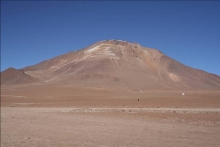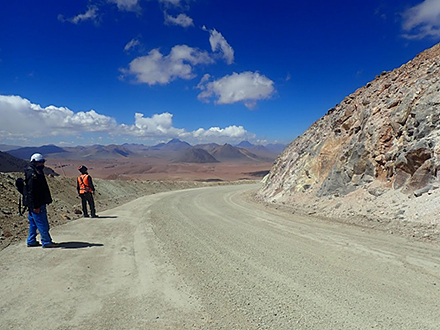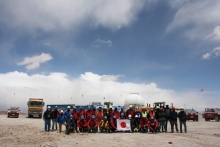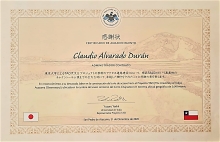
|
TAO Project |
|
The TAO project

|
Access Road to the summit of Co. Chajnantor has been expandedHistory of the road expansionBefore construction of the mini-TAO telescope, there was no road to access the summit of Co. Chajnantor. So we had to walk to the summit for our site survey (all the work is now made with breathing oxygen from a portable oxygen cylinder, but at that time we had no such knowledge and climbed without oxygen). Afterwards construction of a new road was proceeded for the mini-TAO telescope, and an access road to the summit opened in April 2006. Since then we have used the road for our observation and operation. But this access road was too narrow and the slope was too steep to raise the materials needed for the construction of 6.5 meter telescope, which has much larger diameter and the scale of operation. In particular, for transporting the primary mirror (glass material with a diameter of 6.5 m), which is the heart of the telescope, it is essential to have a road with sufficient width and flatness to ensure safety. Road designTherefore, the initial work on site for the construction of the TAO 6.5m telescope was expansion of the summit access road. Prior to the expansion work, the width and slope of the road were studied based on the size and weight of the goods to be transported, and snow conditions of this area were also taken into account to design a road that could transport the goods needed for the construction of the TAO telescope. First, assuming that the largest item to be transported, an upper part of the coating chamber (8 m in diameter and weighing more than 30 tons), the necessary road width, gradient, hairpin curve radius, and other design conditions were determined through road profile analysis. Subsequently, for curves where it was difficult to meet conditions due to cliffs and other topographical problems, the design was modified on the premise of making minor adjustments such as improving the ground, changing the transportation method to switchbacks, and widening the road to increase the number of towing vehicles during transportation. In addition, considering the presence of permafrost revealed by the survey, we adjusted the road design such as expansion width and so on. Road expansion worksThe road expansion work started in 2018. As mentioned above, permafrost was found in the ground during construction. The presence of permafrost at such a low latitude as Atacama shows how high Co. Chajnantor is. Any change in the thermal environment due to road construction, even a local topographic change, can cause this permafrost to thaw and lead to road collapse. To avoid this, we carefully proceeded the construction of the road, considering the distribution and size of the permafrost. On the other hand, the Chilean government has notified us that it will set new, stricter safety rules for work at altitudes of 5,500 m or higher. We were forced to spend a considerable amount of time building a construction system that met those standards. It was unexpected situation. In addition, the worldwide spread of the new coronavirus (COVID-19) caused various difficulties, including intermittent halt of the construction. By the end of December 2020, the entire road was finally opened to traffic, and the construction company handed over the road to TAO after putting the final touches by the end of March 2021. This road not only accelerates summit construction, but also contributes to a much higher level of safety for construction personnel. Currently, the road is used to transport materials, and construction of the operation building and the enclosure on the summit is underway. A trial run will also be planned with a dummy cargo of the same dimensions and weight as the coating chamber The world's highest observatory, which will be built on permafrost unparalleled in the world, is built on such literal steady work that will never see the light of day when it is completed. With the completion of the access road, the TAO project has taken another step toward approaching installation and operation of the TAO telescope.
Copyright(c) 2022 TAO Project, Institute of Astronomy, Graduate School of Science, University of Tokyo
|





